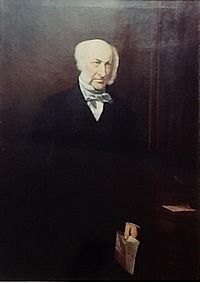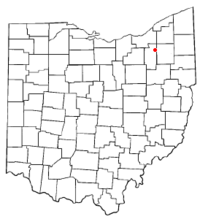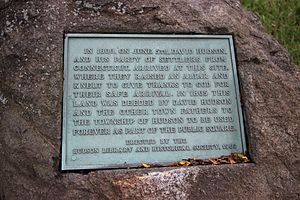David Hudson (pioneer) facts for kids
Quick facts for kids
David Hudson
|
|
|---|---|

Portrait of David Hudson by J. O. Osborne (circa 1851)
|
|
| Born | February 17, 1761 Branford, Connecticut, U.S.
|
| Died | March 17, 1836 (aged 75) Hudson, Ohio, U.S.
|
| Known for | Founding Hudson, Ohio |
David Hudson (born February 17, 1761 – died March 17, 1836) was an American businessman. He is famous for founding Hudson Township, which is now the city of Hudson, Ohio.
David Hudson was born in Branford, Connecticut. When he was four years old, his family moved to Goshen, Connecticut. He lived there for many years. In 1783, he married Anna Norton. They raised seven of their nine children in Goshen.
In 1789, Hudson joined a group to buy land in the Connecticut Western Reserve. The next year, he left Goshen to explore this land. He wanted to start a new settlement there. He traveled through New York, along Lake Erie, and south along the Cuyahoga River.
At the new settlement, Hudson and his team built homes. More people moved there over time. Hudson's wife and children eventually joined him. They had two more children in the new township. David Hudson died on March 17, 1836, when he was 75 years old.
Contents
David Hudson's Early Life
David Hudson was born in Branford, Connecticut, on February 17, 1761. He was the youngest child of David Hudson and Rebecca Fowler. His family moved to Goshen, Connecticut, four years later.
There is a family story that David Hudson was a drummer boy during the American Revolutionary War. This war started in 1775, when he was 14. However, his service is not officially confirmed. His name is not in the records of Continental Army officers.
On December 22, 1783, Hudson married Anna Norton. She was the daughter of David Norton and Anna Brownson. They had their first seven children in Goshen. David Hudson owned a large farm there. In 1795, he bought $1,200 worth of shares in the Connecticut Land Company. This company owned a large area of land called the Connecticut Western Reserve.
His Beliefs and Values
David Hudson said that his early experiences with religion shaped his life. His father changed his religious beliefs several times. This made young David a bit unsure about religion at first.
Later, the French Revolution deeply affected him. He was upset by the violence and disrespect for life during the uprising. In 1798, he decided to live a life based on strong moral values. He believed in "morality, religion, law observance and education." These ideas likely guided his actions, including his decision to settle new land in the west.
Founding Hudson Township
The Journey West

In 1795, the Connecticut Land Company bought land in Northeast Ohio. This area was known as the Connecticut Western Reserve. The land was divided into 129 townships, each about 25 square miles (65 km²).
In 1798, David Hudson bought a plot of land in the Reserve. He partnered with Birdsey and Nathaniel Norton for this purchase. On April 22, 1799, Hudson left for the land with a small group of settlers. This group included his son Ira and employees Jesse Linsley and William McKinley.
The group traveled through New York. They went along the Mohawk River valley. They passed through places like Utica and Syracuse. On May 5, they reached East Bloomfield, New York, where Birdsey Norton lived. They restocked their supplies there.
On May 16, 1799, the group traveled north to Lake Ontario. They left from Oswego in several boats. They then traveled west towards Lake Erie.
Hudson thought the trip would take less than a month. But it took 56 days. Most of the journey was by water. Ice on the Niagara River and Lake Erie slowed them down. Parts of the Cuyahoga River were also hard to navigate. One boat was even destroyed by ice near Niagara Falls.
The group finally reached Cleaveland (now Cleveland, Ohio) on June 9, 1799. After buying more supplies, they went down the Cuyahoga River. They reached near present-day Northfield, Ohio on June 20. They had trouble finding the exact borders of their land.
Building Hudson Township
After finding the center of their land, Hudson and his partners built a trail. This trail went from their land to their boat on the Cuyahoga River. It took over a week to build the trail and move their supplies. Then, they built a small shelter and started to establish the township.
The group faced challenges in the first few months. The weather was wet, and food was scarce. Hudson had to travel back to Cleaveland to try and buy food. He wrote in his journal that he had "the most uncomfortable night I ever felt."
When Hudson returned to Cleaveland, he found few settlers and no extra food. He kept going east on Lake Erie. He found food at Cattaraugus Creek in Western New York. He brought it back to the settlement.
By autumn, the settlement had grown to thirteen people. They built a 16 by 18 foot (4.9 by 5.5 m) log house. They also planted a small turnip garden and a 9-acre (3.6 ha) wheat field. Most of the land was surveyed by October 11.
The next day, Hudson, his son Ira, and two other men returned to Goshen, Connecticut. Hudson wanted to sell land in the Western Reserve. He sold land to twenty-eight people. He offered 40 acres (16 ha) to the first buyer.
On January 1, 1800, Hudson and his family left Goshen for their new home. They stopped in Bloomfield, New York. Hudson bought livestock and a year's worth of supplies for $2,000. On April 30, the remaining settlers left in eight boats. They arrived on May 20. On October 28, Anna Hudson gave birth to Anne Maria. She was the first person born in the new settlement.
By the end of 1800, Hudson's colony was the first established settlement in what is now Summit County, Ohio. More settlers arrived in 1801. In 1802, the settlement officially became known as Hudson Township, Ohio.
Life After Founding Hudson
After founding Hudson Township, David Hudson was very involved in buying, selling, and farming land. By 1808, he owned nearly 3,000 acres (1,200 ha) of land. On his farms, he grew hay, potatoes, corn, and wheat. He also raised hogs, oxen, cows, sheep, and horses. He often provided places for visitors to stay in the town.
Hudson was part of about 200 money deals. This made him a very important person in the area. At that time, it was common for employers to pay workers partly with alcohol. Hudson chose not to do this. This was unusual and showed his strong beliefs.
Hudson's home, built in 1805–06, was the first wooden frame house in town. It was two-and-a-half stories tall and measured 40 by 30 feet (12 by 9 m). Besides being his family's home, it was also the town's first post office, a place for travelers to stay, and a courtroom.
Hudson was the township's first postmaster. He held this job until 1829. His house also offered food and shelter to travelers. This included fugitive slaves who were escaping to freedom on the Underground Railroad. Hudson's son, David Jr., kept diaries. He recorded the names of hundreds of people who passed through their home.
Anna Hudson, David's wife, gave birth to their last two children in the township. She died in August 1816. The next January, Hudson married Mari Robinson. David Hudson died on March 17, 1836, at 75 years old.



